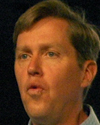
The concept of the universal machine, first articulated by Alan Turing in 1939, is the foundation for many of the ways we work with computers today. Despite stunning advances, Jeff Hawkins highlights a class of computational problems that have been very difficult to tackle such as integrated sensory perception, language and adaptive behaviors. Yet, animal brains, especially the human brain, carry out these functions with relative ease. Hawkins asks, what lessons can we learn from the human brain itself that might assist us in advancing computation in useful ways?
Hawkins focuses on the most interesting part of the brain, the neocortex. Packed with approximately 30 billion neurons, the neocortex is roughly the size and shape of a wrinkled dinner napkin. All areas have the same cellular architecture, but functional regions can be mapped in an interconnected hierarchy. Advances in neuroscience and brain imaging have given birth to a new theory on the origin and functions of the hierarchy - Hierarchical Temporal Memory. As the theory goes, the neocortex starts out fairly devoid of data. Over time, the brain creates models of the world based on experience. By passing raw inputs up through hierarchical units for processing, comparable data patterns are grouped to form concepts. These concepts can then be used as models to draw inferences, make predictions, and turn them into actions.
Numenta has taken these fascinating ideas and developed them into an open computing platform which can be used to explore the theory, and to solve real world problems. A runtime environment provides a framework for Hierarchical Temporal Memory that can be accessed through an API. Hawkins shows an example of a simple vision system that can "see" patterns and learn to make useful predictions from them. More advanced problems such as music and language await future breakthroughs. Many of the tools are freely available as open source.
Jeff Hawkins is best known as co-founder of two companies, Palm and Handspring, and as the architect of many computing products such as the PalmPilot and Treo smartphone. Throughout his life Jeff has also had a deep interest in neuroscience and theories of the neocortex. His interest in the brain led him to create the non-profit Redwood Neuroscience Institute (RNI), a scientific institute focused on understanding how the human neocortex processes information. While at RNI, Hawkins developed a theory of neocortex which appeared in his 2002 book, On Intelligence. With the team of Dileep George and Donna Dubinsky, Hawkins founded Numenta in 2005 to develop a technology platform derived from his theory. It is his hope that Numenta will play a catalytic role in creating an industry based on this theory and technology.
In addition to his work at Numenta, Jeff continues designing products at Palm Inc. Jeff is a member of the scientific board of directors at Cold Spring Harbor Laboratory. He was elected to the National Academy of Engineering in 2003.
Jeff Hawkins earned his B.S. in electrical engineering from Cornell University in 1979.
Resources
This free podcast is from our Emerging Technology Conference series.
For The Conversations Network:
Photo: Jeff Kubina